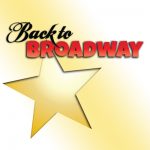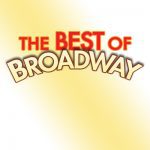Review – High Voltage – The Best of Broadway – June 21, 2017
By Dick Franztreb
I’m waiting for the latest High Voltage show to begin, and from my seat in the parterre section of Harris Center’s Stage 1, I felt a spirit around me, as I observed audience members entering and taking their seats. It wasn’t everyone, of course, but I saw a lot of joyful anticipation as kids of all ages greeted their friends, families connected with families, people who hadn’t seen each other in a while excitedly shared news, and regulars like me just soaked in the love. I could imagine first-timers thinking that a High Voltage show must be a special occasion. Well, it is.
The lights went down, the cell phone/fire exit announcement was given, the curtain went up — and just like that, we all were in Oz for “One Short Day.” The whole High Voltage company was on stage in dazzling green-accented costumes and green sunglasses — under green stage lighting, as I recall. I was instantly reminded about one of the things I enjoy most about these performances. It was the choreography: always interesting, never repetitive — exciting, flawlessly executed, and often with mind-boggling complexity. You can’t help yourself: you don’t want to look away, you don’t want to miss a detail.
So many of the 29 Broadway numbers in this show were also highly choreographed. When appropriate, the dancing reflected a certain style: 1920s moves for “Thoroughly Modern Millie,” 1960s moves for the medley from “Hair,” the distinctive youth gang feel in West Side Story’s “Cool.” But with all the brilliant choreography in a High Voltage production, it’s the execution by the dancers that brings it to life. For example, I’m always impressed with the synchronization of ensemble moves. In a less professional production, you’d see people who haven’t mastered a move and stand out in a group number. Not with EDMT. Although no one’s perfect, and a director’s eye will pick out things that an audience member like me will miss, what I see is every performer moving in perfect sync with the others. This caught my eye especially in “Zero to Hero,” and then it went up a notch in “One.” In that number, the dancers had many beautifully synchronized moves, and then there was a point where they linked arms in a rapidly rotating circle — facing out. At that point, we in the audience couldn’t hold back: we broke out in spontaneous applause and cheers. Then that impressive feat was topped by a 20-person kick line that got more spontaneous applause.
The second number, “Lily’s Eyes” reminded me of another excellent feature of these programs: the projections. They are the work of cast member Zach Wilson. I remember seeing his early efforts 5 years ago, and his art has come very, very far since that time, now even incorporating animations and other special effects. The projections are each completely fresh, and so effective in creating a setting or a mood for each song.
“Lily’s Eyes” also marked the first exhibition of the many excellent solo voices highlighted in this show. Because I respect the integrity of this troupe of 20 talented people, I won’t mention the names behind these solo or duet performances, but “Not for the Life of Me,” “Amayzing Mayzie,” “I Am Adolpho,” “Memory,” “They Don’t Know,” “You’re Nothing Without Me,” and “Be the Hero of Your Story” all showcased some of High Voltage’s truly outstanding singers — and in a couple of cases I felt like I was watching break-out performances of emerging talent. And it’s not just the voices that made these performances so memorable, so engaging. These young people are actors, and their expressive delivery brought each song to life as part of a story.
Every once in a while, I focus on a familiar face on stage, but the voice really surprises me. I forget that these are young people. Sure, they’re talented and hard-working — and brilliantly directed and coached. But their skills are constantly developing. So maybe my surprise is the result of maturity and refinement of talent — or maybe the experienced eye and instincts of Director Debbie Wilson has given them the perfect song for this point in their growth.
The influence of Vocal Director Jennifer Wittmayer is apparent in these solo performances, but it also has ensured excellent ensemble singing. Through this 2016-2017 season I’ve noticed the ensemble singing improve steadily. Most often, there is a single melody line. But tonight I heard a lot of part singing. I don’t expect SATB arrangements in a show like this, but the many times when the ensemble broke into 2-part singing it really added a dimension to the number in question. This was especially well done in “No One Is Alone,” and in “Seasons of Love,” which had the extra dimension of a bit of improvisation and a sustained high note at the end that evoked cheers from the audience.
Let’s talk costumes. These are always a highlight of High Voltage shows, but it seemed that there was even more attention to them than usual this time. I’ve already mentioned the Oz costumes in “One Short Day.” The 60s costumes in the Hair medley were fun, and the ladies’ costumes in “Zero to Hero” were simply dazzling. And the costume for Mayzie the bird in “Amayzing Mayzie,” with it’s outrageous tail, was a work of art.
And speaking of costumes, I think there should be some recognition for the costume assistants offstage, who help the performers through some lightning-fast costume changes. That reminds me of one of the things that I especially admire about High Voltage: its ethos. There are no stars — it’s all about the troupe. When a number is over, the lights go out on the applause, and the performer or performers run offstage in the dark: no bows. The music ends and the next song begins. On this night I saw a brilliant solo performance end in darkness, and in 30 seconds that performer ran out, costume changed, to join the ensemble number that was already underway — and deliver the third short solo line of the song. Show business isn’t for sissies.
I’ve pointed out how the acting skills of these young people can really sell a serious song. But a High Voltage show is full of comedy, as well. A lot of the humor is staged by Director Debbie Wilson. For example, there were cute walk-ons in “Be the Hero of Your Story” that illustrated the lyrics of the song. Then at the end, fish were thrown onstage from the wings, making a sight gag of the “teach a man to fish” maxim.
But the comedic skills of the performers stood out so often: in the French-accented overacting in “Canaan Days,” the cane-twirling arrogance in “Adolpho,” the high-energy dancing and acting of “Positive.” Many more highlights came in ways that seemed less scripted to me. Let me explain. There are lots of times where it seems like Director Debbie Wilson is turning these performers loose to ad lib gestures in a number. On this night there were several possible examples of this: the Hair medley, “Gee, Officer Krupke,” “New York, New York,” “Canaan Days,” etc. I must say these moments of apparently unscripted chaos are among my favorites; they seem so genuine and uninhibited.
Of all the seriously acted pieces, I’d have to single out “Façade” as a work of art. This was the darkest piece on the program, and the lighting, projection, choreography and body language really emphasized the song’s anger, irony and cynicism. Sweetness and light were out the window, and this scene was extraordinarily well done. Perhaps I should mention here something else I observed throughout the evening. There were times when I’d force myself, watching a stage full of performers, to look away from the soloist or center of the action to the others in the group. The spotlight wasn’t on them, but I saw people who were always acting, supporting the story. That’s commitment to the group, and that’s professionalism.
And speaking of professionalism, what could have demonstrated that better than tonight’s finale, the medley of music from Hamilton. This was a tour de force, a group of songs from the show and a bit of dialog that effectively told the whole Hamilton story. I don’t know how they put it together from their own resources, but it was a masterpiece of performing artistry. For a start, the energy was over the top. The music seemed impossibly difficult to sing, especially with the frequent machine-gun, rap lyrics. The choreography was full of what I would have to call contemporary or hip-hop dance moves, and the effect was mesmerizing. The performance seemed suspended in time; the audience was intensely attentive, and there were many points where they wanted to interrupt with applause. When it was over, I’ve never seen people rise so quickly from their seats, not just with applause, but with sustained cheers.
I spoke to a few of the performers afterwards, and they were dripping with sweat. I looked down the line of these 20 young people, and the thought occurred to me that I loved each of them. I know a few of them very casually, but the rest of them not at all. But what I felt was love. And how could you not love them? They have each spent years in training of one kind or another, months in learning — perfectly — intensely difficult songs and choreography. And then they put themselves up for your critical attention, pouring out their emotion, energy and talent to keep you entertained for 2 hours. Why do they do it? They don’t get paid. They do it for love, for love of the art, for love of their fellow performers and mentors, for love of the opportunity to be truly alive on that stage and under the lights. Yes, love is what it’s about, and it’s love that keeps me coming to every show. Catch the next High Voltage performance, and you’ll feel the love, too.





